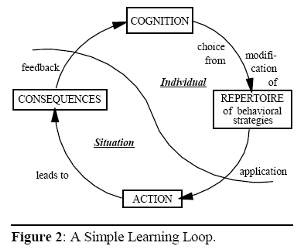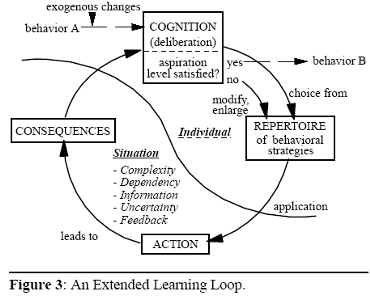In a behavioral perspective, learning may generally be defined as an enduring change in behavior, or in the capacity to behave in a given fashion, which results from practice or other forms of experience.[50] The three main elements of this definition are (i) the occurrence of an actual or potential change in behavior, (ii) the persistence of this change, and (iii) the change’s origin in practice or other forms of experience. Hence, learning leads to changes in behavior through interaction with the environment, and – since learning is a process – a concept of its basic dynamics is required that links the cognition and behavior of an individual to the situation.
Figure 2 presents a simple learning loop where cognition allows the individual to choose a behavioral strategy from a repertoire of strategies (that has been developed in previous interaction with the environment), and apply that strategy to a situation by some action that yields consequences which feed back to the individual. Depending on these consequences, the repertoire may be modified, and a new or revised strategy may be chosen, thereby inducing an additional turn of the loop to a higher level of experience.[51]

In order to integrate this basic concept of learning into the methodology of the economic approach as presented in the previous section, a traditional, stable pattern of equilibrium behavior (A) is assumed that is challenged by exogenous changes in economic restrictions or relative prices (see top of Figure 3). These changes induce cognitive processes, if a certain aspiration level is not satisfied – otherwise (unchanged) behavior B results.

Given that the aspiration level is not met, a behavioral strategy is chosen from the individual’s repertoire, and applied to the situation where it leads to consequences that feed back to the individual, inducing deliberation.[52] If the feedback indicates that the chosen action yields consequences that do not restore the aspiration level, the applied strategy may be modified, or a new strategy may be chosen from the repertoire, and applied to the situation.
This process continues until the aspiration level is satisfied, and a new equilibrium behavior (B) results.[53] Note that in Figure 3 the situation is characterized by five situational factors that will next be explained in more detail.
50 See eg., SCHUNK (1991).
51 Hence, the loop may be better presented as a spiral where each turn represents a higher level of experience incorporated in an enlargement of the repertoire over time. The third dimension missing in Figure 2, thus, may be interpreted in terms of accumulation of knowledge, or cognitive development over time.
52 The notion of an aspiration level is an example how bounded rationality can be combined with contingent learning, but this notion can be replaced by a maximizing assumption so that, given the exogenous changes, learning ends when utility is maximized under the new restrictions.
53 Again, this process may better be represented by a spiral where experience and knowledge accumulate over time, and behavior is modified until the aspiration level is restored. – For simplicity, the aspiration level is assumed to be constant, though aspiration level models in psychology suggest that the aspiration level may be affected by experience (see KLEINDORFER, KUNREUTHER & SCHOEMAKER (1993, 41) for references).
Prof. Tilman Slembeck
Next: Determinants of Learning
Summary: Index